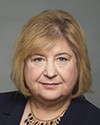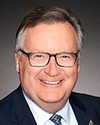On the meat cutting program, once again thank you for assisting in that and involving me in the dialogue. The Sandy Bay meat cutting program is a first nations training program that's quite unique in the sense of where we're located. It's one of the first. We have gone through seven cohorts. We've had a 96% success completion rate. They are currently expanding into the area of beef. We were able to form many partnerships for employment retention, for instance with HyLife, but also with northern companies that have hired quite a few of our people who have completed the program.
I'll use HyLife as an example. We transport our people who don't have a means of transportation and charge them a small fee for getting to and from work. We have two drivers who drive I believe it's about 12 people in each of these vans. It's been very successful. Some have also moved into Neepawa and have begun to become more self-sufficient, and their responsibilities are quite unique. Seeing how people became very self-aware after completing this program was sui generis.
I do recall a couple of people who kept themselves away from people. Seeing these people today, you would never know that they would seclude themselves. They're animated. They're engaging. It's quite heartwarming.
In terms of the future of the meat cutting course, we are definitely encountering barriers once again as a flow-through from Service Canada and ISC down to FPDI and then down to the first nation. FPDI has definitely taken upon itself to try to dictate to the community what the service model should be, which isn't the case.
As a result of it, we've been met with issues of flow-through monies down to the first nation, which should never be the case. But it is occurring. We are definitely trying to find another means. We have submitted some letters to Service Canada to once again engage in a direct relationship with them. We're hopeful that we will be successful within the next half year.




